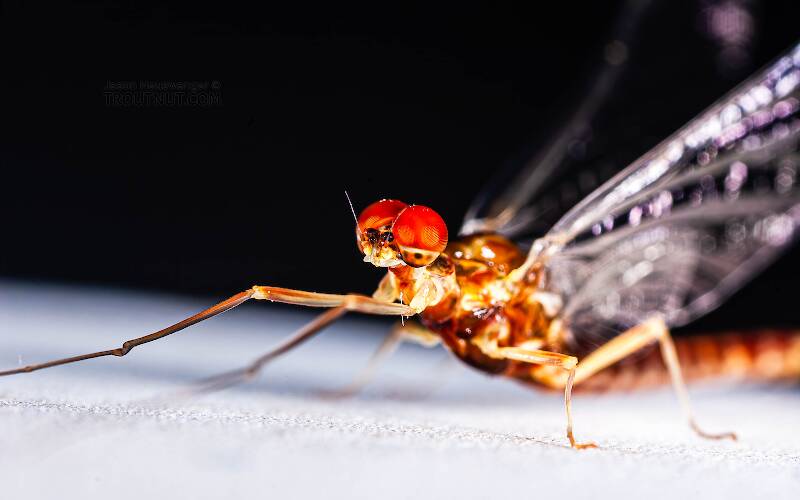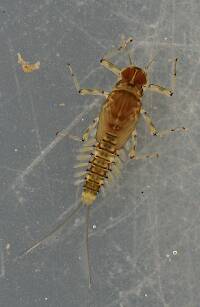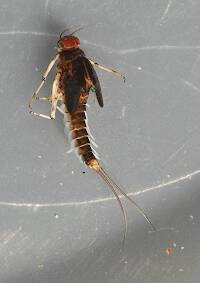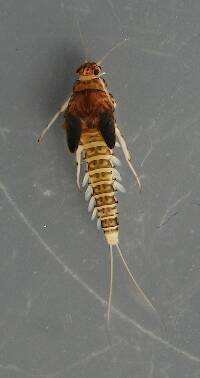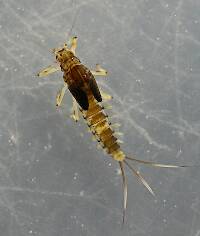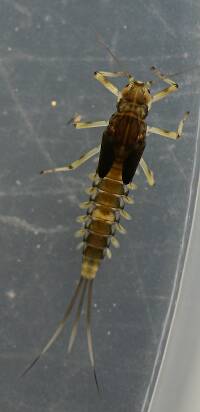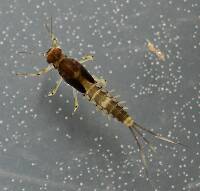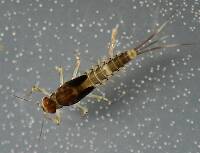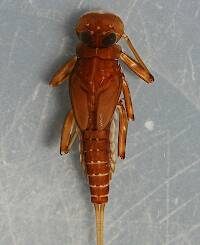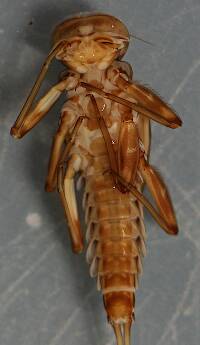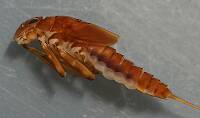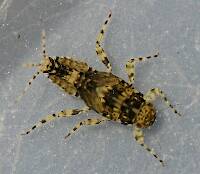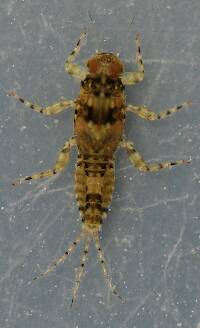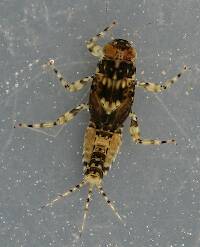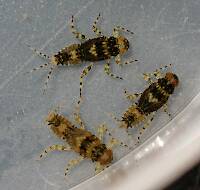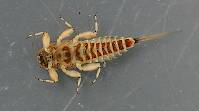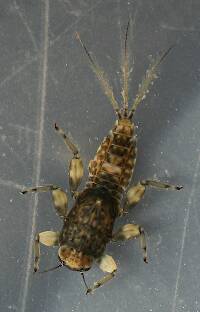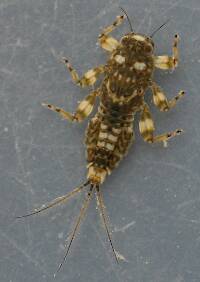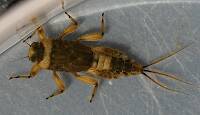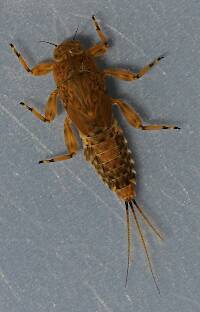
Salmonflies
Pteronarcys californica
The giant Salmonflies of the Western mountains are legendary for their proclivity to elicit consistent dry-fly action and ferocious strikes.
Featured on the forum

Some characteristics from the microscope images for the tentative species id: The postero-lateral projections are found only on segment 9, not segment 8. Based on the key in Jacobus et al. (2014), it appears to key to Neoleptophlebia adoptiva or Neoleptophlebia heteronea, same as this specimen with pretty different abdominal markings. However, distinguishing between those calls for comparing the lengths of the second and third segment of the labial palp, and this one (like the other one) only seems to have two segments. So I'm stuck on them both. It's likely that the fact that they're immature nymphs stymies identification in some important way.

Troutnut is a project started in 2003 by salmonid ecologist Jason "Troutnut" Neuswanger to help anglers and
fly tyers unabashedly embrace the entomological side of the sport. Learn more about Troutnut or
support the project for an enhanced experience here.
This topic is about the Mayfly Genus Ephemerella
This genus contains the legendary Hendricksons and Sulphurs of the East and the equally important Pale Morning Duns of western waters.No scientific name in American angling literature is more renowned and at the same time capable of more confusion than the genus name "Ephemerella." It is important that anglers have a good overall grasp of its taxonomic history if they are to make any sense out of the rich literary heritage involving this mayfly name.
By the time American angling literature began to take serious note of entomology in the decades of the early to mid 20th century, Ephemerella was considered a "super-genus" in the family Baetidae, containing all of the important species to anglers in the subfamily Ephemerellinae. Taxonomists organized them by association with "type" species that were referred to as "groups" within this very large and unruly genus.
This organizational structure held sway until the 70's when they were recognized as separate from the Baetidae with their own family, the Ephemerellidae. The "groups" (after a little name changing and reorganization) were given subgenus status, but in conformance with taxonomical convention,the nomenclature retained the use of the name Ephemerella when referring to individual species genus status. More change occurred towards the end of the century as consensus formed around the subgenera achieving full generic status. The broad use of Ephemerella was then dropped in favor of the new generic names.
These changes were necessary in that they addressed many problems exposed in older taxonomies. Unfortunately, all during this period the changes were reported with varying degrees of accuracy and acceptance. For anglers this was exacerbated by the continued use and reliance on older entomology texts in many circles. Be that as it may, recent or updated angler entomologies now recognize that many of the old Ephemerella species are spread out among several genera in the Ephemerellidae family. These include the various Blue-Winged Olives and Western Green Drakes of the Drunella genus as well as several important species scattered in genera like Attenella and Serratella, to name a few.
Despite these revisions in classification, the Ephemerella genus still contains arguably the most important species in North America, and remains a "super-genus" to anglers.
There is a lot of variation; refer to the genus species hatch pages for details.
Example specimens
Alisadeq
Posts: 1
Posts: 1
Alisadeq on May 14, 2008May 14th, 2008, 12:51 am EDT
on the long time am looking for akey to mayflies (larvae) please if you have any information about this subject you can send it to me on my
e.mail(sama_rania@yahoo.com)
thank you
e.mail(sama_rania@yahoo.com)
thank you
Taxon on May 14, 2008May 14th, 2008, 4:24 am EDT
Alisadeq-
For what geographic location, North America, or somewhere else? For which taxonomic group, only Ephemerella, or all of Ephemeroptera? For what taxonomic levels, family, genus, or species?
Taxonomic keys for mayfly larvae (nymphs) would differ significantly between continents, particularly below family level. For example, probably over 50% percent of the genera present on the European continent, are not present on the N. American continent, and vice versa. And, at the species level, there would be virtually no commonality.
For what geographic location, North America, or somewhere else? For which taxonomic group, only Ephemerella, or all of Ephemeroptera? For what taxonomic levels, family, genus, or species?
Taxonomic keys for mayfly larvae (nymphs) would differ significantly between continents, particularly below family level. For example, probably over 50% percent of the genera present on the European continent, are not present on the N. American continent, and vice versa. And, at the species level, there would be virtually no commonality.
Troutnut on May 15, 2008May 15th, 2008, 3:12 pm EDT
He sent me an email about this, too, and said he's looking for a key to the mayfly and stonefly nymphs of Iraq. I don't know any... does anyone here?
Jason Neuswanger, Ph.D.
Troutnut and salmonid ecologist
Troutnut and salmonid ecologist
Konchu on May 15, 2008May 15th, 2008, 3:23 pm EDT
I'm not aware of a key, but there is a 20-yr old list of Ephemeroptera from Iraq.
Al-Zubaidi F; Braasch D; Al-Kayatt A. 1987. Mayflies from Iraq (Insecta, Ephemeroptera). Faunistische Abhandlungen Staatliches Museum für Tierkunde Dresden 14:179-184.
A pdf-file is available from Michael Hubbard and his Florida A&M colleagues at the following URL.
http://www.famu.org/mayfly/mfbib_a.php
Some of the terminology and classification is out-of-date, but it at least is a start towards narrowing the list of possibilities.
Al-Zubaidi F; Braasch D; Al-Kayatt A. 1987. Mayflies from Iraq (Insecta, Ephemeroptera). Faunistische Abhandlungen Staatliches Museum für Tierkunde Dresden 14:179-184.
A pdf-file is available from Michael Hubbard and his Florida A&M colleagues at the following URL.
http://www.famu.org/mayfly/mfbib_a.php
Some of the terminology and classification is out-of-date, but it at least is a start towards narrowing the list of possibilities.
Quick Reply
Related Discussions
Topic
Replies
Last Reply
2
Nov 12, 2012
by Entoman
by Entoman




